University Essay: Psychological Analysis of The Great Gatsby
VerifiedAdded on 2022/10/10
|10
|2760
|458
Essay
AI Summary
This essay offers a detailed psychological analysis of F. Scott Fitzgerald's The Great Gatsby, focusing on the character of Jay Gatsby. The essay explores Gatsby's psychological development, examining his motivations, relationships, and actions within the context of the novel. It applies two key developmental psychological theories: cognitive development and attachment theory, to understand Gatsby's mental processes and emotional attachments. The analysis delves into how Gatsby's past experiences, including abandonment and his desire for Daisy Buchanan, shaped his personality and behavior. The essay also considers the significance of psychology in understanding human behavior and maintaining cultural norms. The narrative follows Nick Carraway's perspective, offering insights into the lavish parties, social dynamics, and tragic events that define Gatsby's life and relationships, culminating in his untimely death and the aftermath. The essay concludes by highlighting the importance of psychological understanding in interpreting literary characters and human behavior.
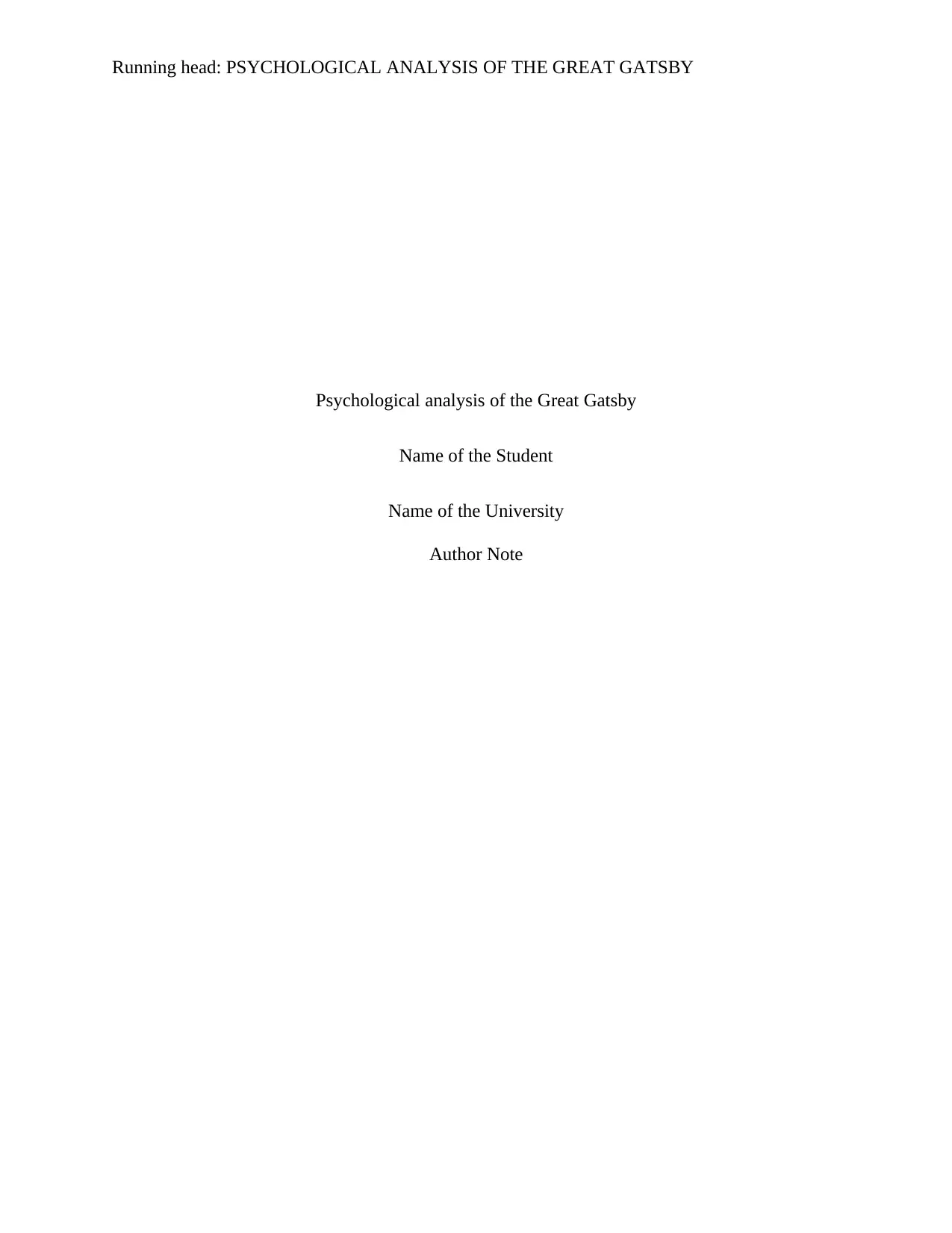
Running head: PSYCHOLOGICAL ANALYSIS OF THE GREAT GATSBY
Psychological analysis of the Great Gatsby
Name of the Student
Name of the University
Author Note
Psychological analysis of the Great Gatsby
Name of the Student
Name of the University
Author Note
Paraphrase This Document
Need a fresh take? Get an instant paraphrase of this document with our AI Paraphraser
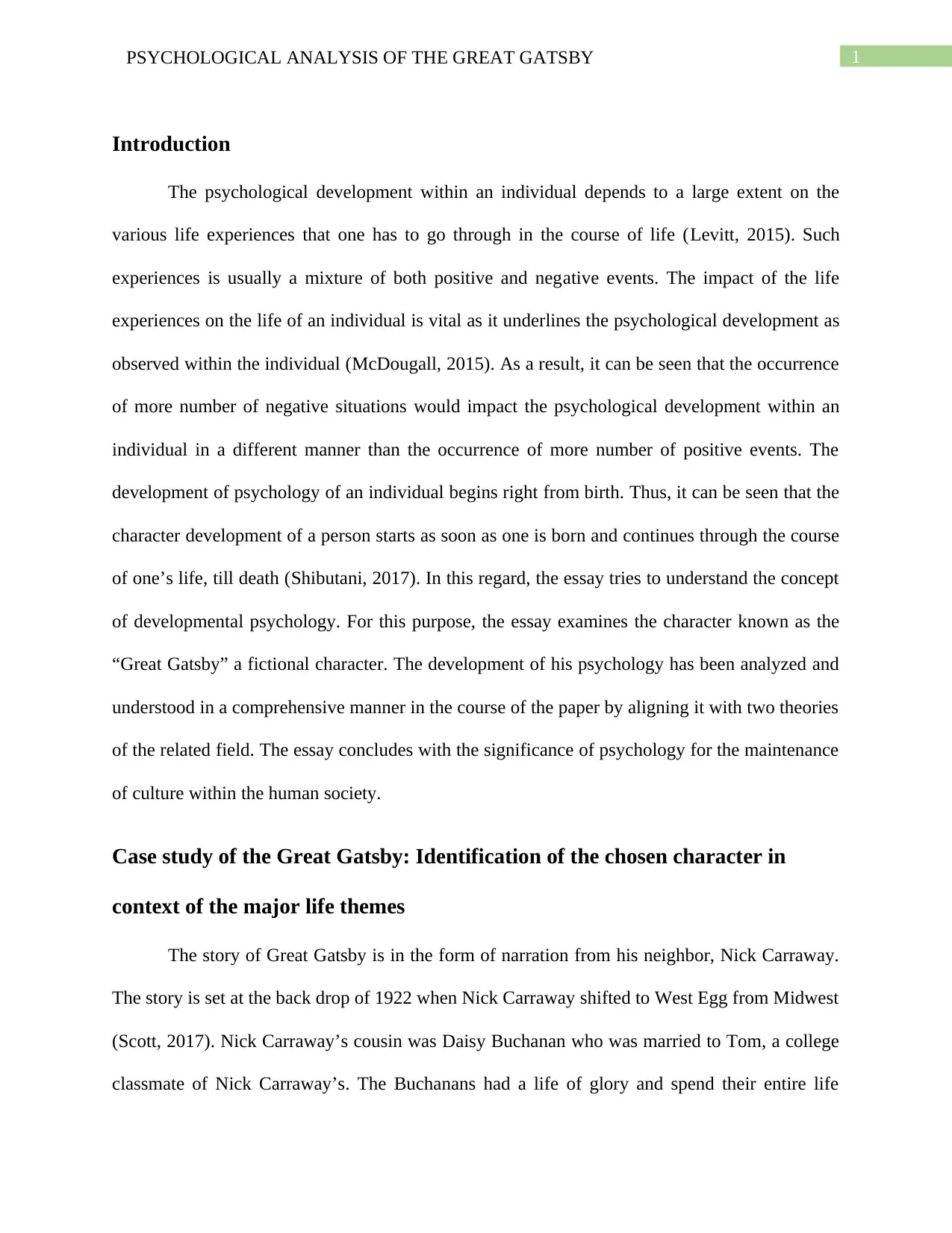
1PSYCHOLOGICAL ANALYSIS OF THE GREAT GATSBY
Introduction
The psychological development within an individual depends to a large extent on the
various life experiences that one has to go through in the course of life (Levitt, 2015). Such
experiences is usually a mixture of both positive and negative events. The impact of the life
experiences on the life of an individual is vital as it underlines the psychological development as
observed within the individual (McDougall, 2015). As a result, it can be seen that the occurrence
of more number of negative situations would impact the psychological development within an
individual in a different manner than the occurrence of more number of positive events. The
development of psychology of an individual begins right from birth. Thus, it can be seen that the
character development of a person starts as soon as one is born and continues through the course
of one’s life, till death (Shibutani, 2017). In this regard, the essay tries to understand the concept
of developmental psychology. For this purpose, the essay examines the character known as the
“Great Gatsby” a fictional character. The development of his psychology has been analyzed and
understood in a comprehensive manner in the course of the paper by aligning it with two theories
of the related field. The essay concludes with the significance of psychology for the maintenance
of culture within the human society.
Case study of the Great Gatsby: Identification of the chosen character in
context of the major life themes
The story of Great Gatsby is in the form of narration from his neighbor, Nick Carraway.
The story is set at the back drop of 1922 when Nick Carraway shifted to West Egg from Midwest
(Scott, 2017). Nick Carraway’s cousin was Daisy Buchanan who was married to Tom, a college
classmate of Nick Carraway’s. The Buchanans had a life of glory and spend their entire life
Introduction
The psychological development within an individual depends to a large extent on the
various life experiences that one has to go through in the course of life (Levitt, 2015). Such
experiences is usually a mixture of both positive and negative events. The impact of the life
experiences on the life of an individual is vital as it underlines the psychological development as
observed within the individual (McDougall, 2015). As a result, it can be seen that the occurrence
of more number of negative situations would impact the psychological development within an
individual in a different manner than the occurrence of more number of positive events. The
development of psychology of an individual begins right from birth. Thus, it can be seen that the
character development of a person starts as soon as one is born and continues through the course
of one’s life, till death (Shibutani, 2017). In this regard, the essay tries to understand the concept
of developmental psychology. For this purpose, the essay examines the character known as the
“Great Gatsby” a fictional character. The development of his psychology has been analyzed and
understood in a comprehensive manner in the course of the paper by aligning it with two theories
of the related field. The essay concludes with the significance of psychology for the maintenance
of culture within the human society.
Case study of the Great Gatsby: Identification of the chosen character in
context of the major life themes
The story of Great Gatsby is in the form of narration from his neighbor, Nick Carraway.
The story is set at the back drop of 1922 when Nick Carraway shifted to West Egg from Midwest
(Scott, 2017). Nick Carraway’s cousin was Daisy Buchanan who was married to Tom, a college
classmate of Nick Carraway’s. The Buchanans had a life of glory and spend their entire life
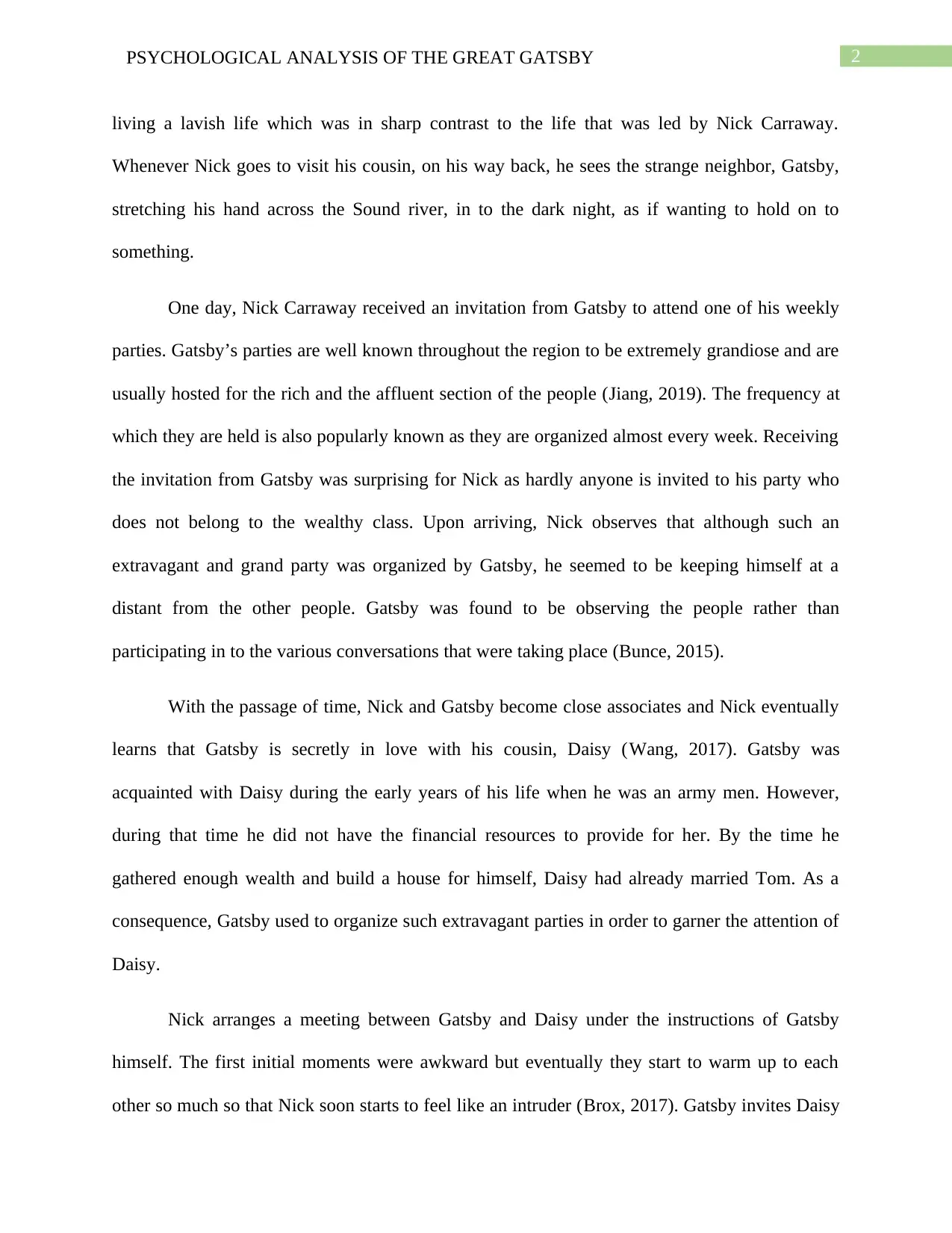
2PSYCHOLOGICAL ANALYSIS OF THE GREAT GATSBY
living a lavish life which was in sharp contrast to the life that was led by Nick Carraway.
Whenever Nick goes to visit his cousin, on his way back, he sees the strange neighbor, Gatsby,
stretching his hand across the Sound river, in to the dark night, as if wanting to hold on to
something.
One day, Nick Carraway received an invitation from Gatsby to attend one of his weekly
parties. Gatsby’s parties are well known throughout the region to be extremely grandiose and are
usually hosted for the rich and the affluent section of the people (Jiang, 2019). The frequency at
which they are held is also popularly known as they are organized almost every week. Receiving
the invitation from Gatsby was surprising for Nick as hardly anyone is invited to his party who
does not belong to the wealthy class. Upon arriving, Nick observes that although such an
extravagant and grand party was organized by Gatsby, he seemed to be keeping himself at a
distant from the other people. Gatsby was found to be observing the people rather than
participating in to the various conversations that were taking place (Bunce, 2015).
With the passage of time, Nick and Gatsby become close associates and Nick eventually
learns that Gatsby is secretly in love with his cousin, Daisy (Wang, 2017). Gatsby was
acquainted with Daisy during the early years of his life when he was an army men. However,
during that time he did not have the financial resources to provide for her. By the time he
gathered enough wealth and build a house for himself, Daisy had already married Tom. As a
consequence, Gatsby used to organize such extravagant parties in order to garner the attention of
Daisy.
Nick arranges a meeting between Gatsby and Daisy under the instructions of Gatsby
himself. The first initial moments were awkward but eventually they start to warm up to each
other so much so that Nick soon starts to feel like an intruder (Brox, 2017). Gatsby invites Daisy
living a lavish life which was in sharp contrast to the life that was led by Nick Carraway.
Whenever Nick goes to visit his cousin, on his way back, he sees the strange neighbor, Gatsby,
stretching his hand across the Sound river, in to the dark night, as if wanting to hold on to
something.
One day, Nick Carraway received an invitation from Gatsby to attend one of his weekly
parties. Gatsby’s parties are well known throughout the region to be extremely grandiose and are
usually hosted for the rich and the affluent section of the people (Jiang, 2019). The frequency at
which they are held is also popularly known as they are organized almost every week. Receiving
the invitation from Gatsby was surprising for Nick as hardly anyone is invited to his party who
does not belong to the wealthy class. Upon arriving, Nick observes that although such an
extravagant and grand party was organized by Gatsby, he seemed to be keeping himself at a
distant from the other people. Gatsby was found to be observing the people rather than
participating in to the various conversations that were taking place (Bunce, 2015).
With the passage of time, Nick and Gatsby become close associates and Nick eventually
learns that Gatsby is secretly in love with his cousin, Daisy (Wang, 2017). Gatsby was
acquainted with Daisy during the early years of his life when he was an army men. However,
during that time he did not have the financial resources to provide for her. By the time he
gathered enough wealth and build a house for himself, Daisy had already married Tom. As a
consequence, Gatsby used to organize such extravagant parties in order to garner the attention of
Daisy.
Nick arranges a meeting between Gatsby and Daisy under the instructions of Gatsby
himself. The first initial moments were awkward but eventually they start to warm up to each
other so much so that Nick soon starts to feel like an intruder (Brox, 2017). Gatsby invites Daisy
⊘ This is a preview!⊘
Do you want full access?
Subscribe today to unlock all pages.

Trusted by 1+ million students worldwide
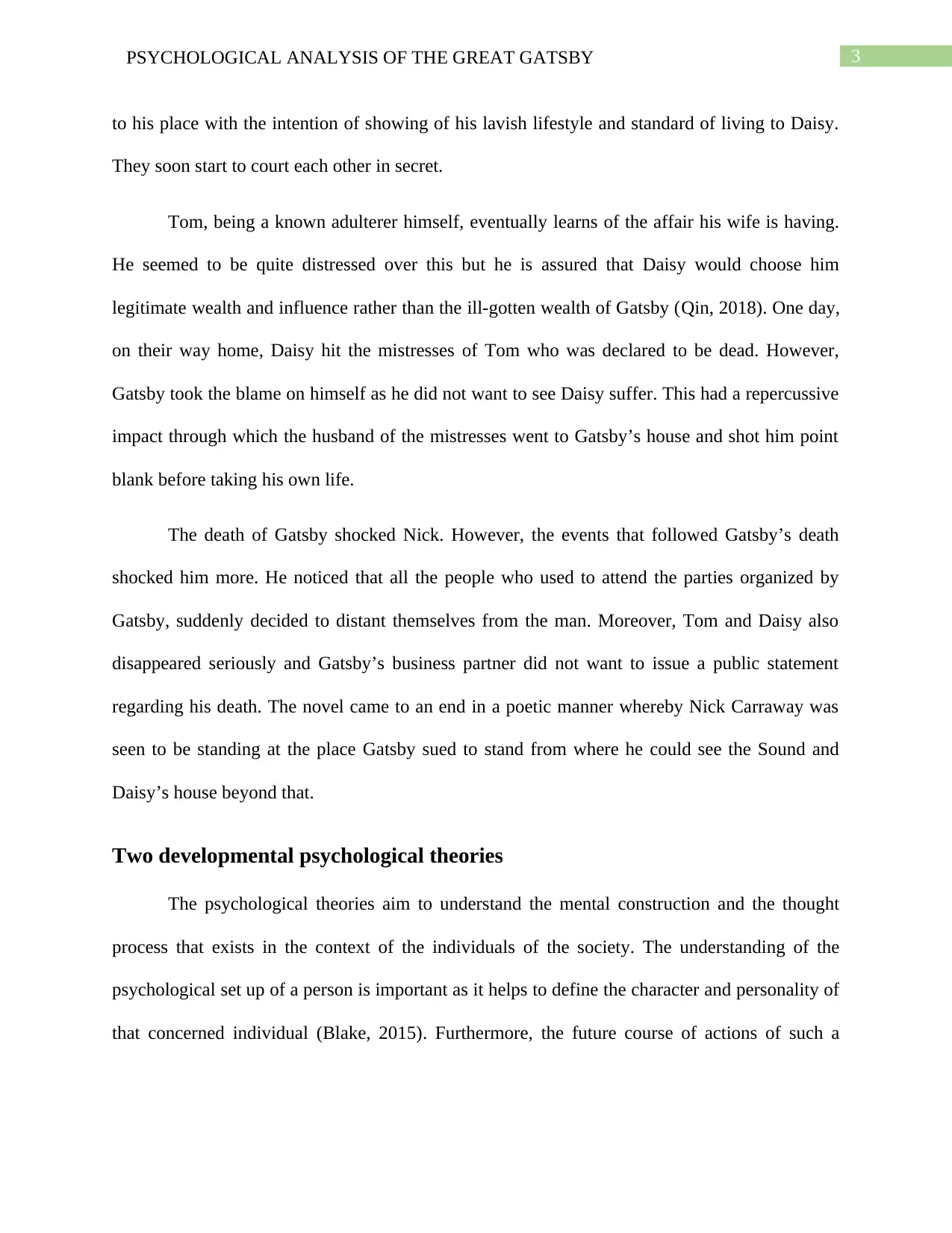
3PSYCHOLOGICAL ANALYSIS OF THE GREAT GATSBY
to his place with the intention of showing of his lavish lifestyle and standard of living to Daisy.
They soon start to court each other in secret.
Tom, being a known adulterer himself, eventually learns of the affair his wife is having.
He seemed to be quite distressed over this but he is assured that Daisy would choose him
legitimate wealth and influence rather than the ill-gotten wealth of Gatsby (Qin, 2018). One day,
on their way home, Daisy hit the mistresses of Tom who was declared to be dead. However,
Gatsby took the blame on himself as he did not want to see Daisy suffer. This had a repercussive
impact through which the husband of the mistresses went to Gatsby’s house and shot him point
blank before taking his own life.
The death of Gatsby shocked Nick. However, the events that followed Gatsby’s death
shocked him more. He noticed that all the people who used to attend the parties organized by
Gatsby, suddenly decided to distant themselves from the man. Moreover, Tom and Daisy also
disappeared seriously and Gatsby’s business partner did not want to issue a public statement
regarding his death. The novel came to an end in a poetic manner whereby Nick Carraway was
seen to be standing at the place Gatsby sued to stand from where he could see the Sound and
Daisy’s house beyond that.
Two developmental psychological theories
The psychological theories aim to understand the mental construction and the thought
process that exists in the context of the individuals of the society. The understanding of the
psychological set up of a person is important as it helps to define the character and personality of
that concerned individual (Blake, 2015). Furthermore, the future course of actions of such a
to his place with the intention of showing of his lavish lifestyle and standard of living to Daisy.
They soon start to court each other in secret.
Tom, being a known adulterer himself, eventually learns of the affair his wife is having.
He seemed to be quite distressed over this but he is assured that Daisy would choose him
legitimate wealth and influence rather than the ill-gotten wealth of Gatsby (Qin, 2018). One day,
on their way home, Daisy hit the mistresses of Tom who was declared to be dead. However,
Gatsby took the blame on himself as he did not want to see Daisy suffer. This had a repercussive
impact through which the husband of the mistresses went to Gatsby’s house and shot him point
blank before taking his own life.
The death of Gatsby shocked Nick. However, the events that followed Gatsby’s death
shocked him more. He noticed that all the people who used to attend the parties organized by
Gatsby, suddenly decided to distant themselves from the man. Moreover, Tom and Daisy also
disappeared seriously and Gatsby’s business partner did not want to issue a public statement
regarding his death. The novel came to an end in a poetic manner whereby Nick Carraway was
seen to be standing at the place Gatsby sued to stand from where he could see the Sound and
Daisy’s house beyond that.
Two developmental psychological theories
The psychological theories aim to understand the mental construction and the thought
process that exists in the context of the individuals of the society. The understanding of the
psychological set up of a person is important as it helps to define the character and personality of
that concerned individual (Blake, 2015). Furthermore, the future course of actions of such a
Paraphrase This Document
Need a fresh take? Get an instant paraphrase of this document with our AI Paraphraser
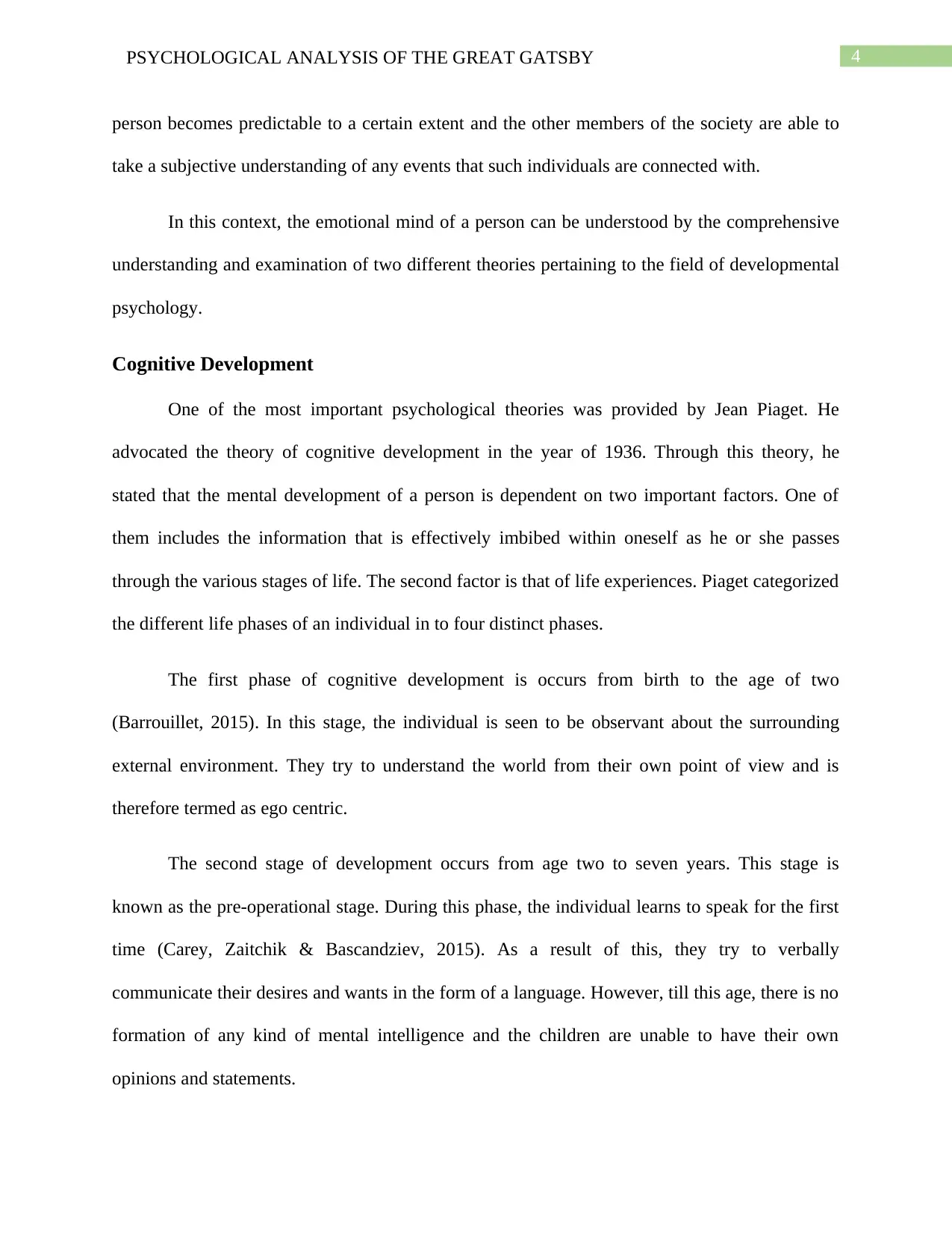
4PSYCHOLOGICAL ANALYSIS OF THE GREAT GATSBY
person becomes predictable to a certain extent and the other members of the society are able to
take a subjective understanding of any events that such individuals are connected with.
In this context, the emotional mind of a person can be understood by the comprehensive
understanding and examination of two different theories pertaining to the field of developmental
psychology.
Cognitive Development
One of the most important psychological theories was provided by Jean Piaget. He
advocated the theory of cognitive development in the year of 1936. Through this theory, he
stated that the mental development of a person is dependent on two important factors. One of
them includes the information that is effectively imbibed within oneself as he or she passes
through the various stages of life. The second factor is that of life experiences. Piaget categorized
the different life phases of an individual in to four distinct phases.
The first phase of cognitive development is occurs from birth to the age of two
(Barrouillet, 2015). In this stage, the individual is seen to be observant about the surrounding
external environment. They try to understand the world from their own point of view and is
therefore termed as ego centric.
The second stage of development occurs from age two to seven years. This stage is
known as the pre-operational stage. During this phase, the individual learns to speak for the first
time (Carey, Zaitchik & Bascandziev, 2015). As a result of this, they try to verbally
communicate their desires and wants in the form of a language. However, till this age, there is no
formation of any kind of mental intelligence and the children are unable to have their own
opinions and statements.
person becomes predictable to a certain extent and the other members of the society are able to
take a subjective understanding of any events that such individuals are connected with.
In this context, the emotional mind of a person can be understood by the comprehensive
understanding and examination of two different theories pertaining to the field of developmental
psychology.
Cognitive Development
One of the most important psychological theories was provided by Jean Piaget. He
advocated the theory of cognitive development in the year of 1936. Through this theory, he
stated that the mental development of a person is dependent on two important factors. One of
them includes the information that is effectively imbibed within oneself as he or she passes
through the various stages of life. The second factor is that of life experiences. Piaget categorized
the different life phases of an individual in to four distinct phases.
The first phase of cognitive development is occurs from birth to the age of two
(Barrouillet, 2015). In this stage, the individual is seen to be observant about the surrounding
external environment. They try to understand the world from their own point of view and is
therefore termed as ego centric.
The second stage of development occurs from age two to seven years. This stage is
known as the pre-operational stage. During this phase, the individual learns to speak for the first
time (Carey, Zaitchik & Bascandziev, 2015). As a result of this, they try to verbally
communicate their desires and wants in the form of a language. However, till this age, there is no
formation of any kind of mental intelligence and the children are unable to have their own
opinions and statements.
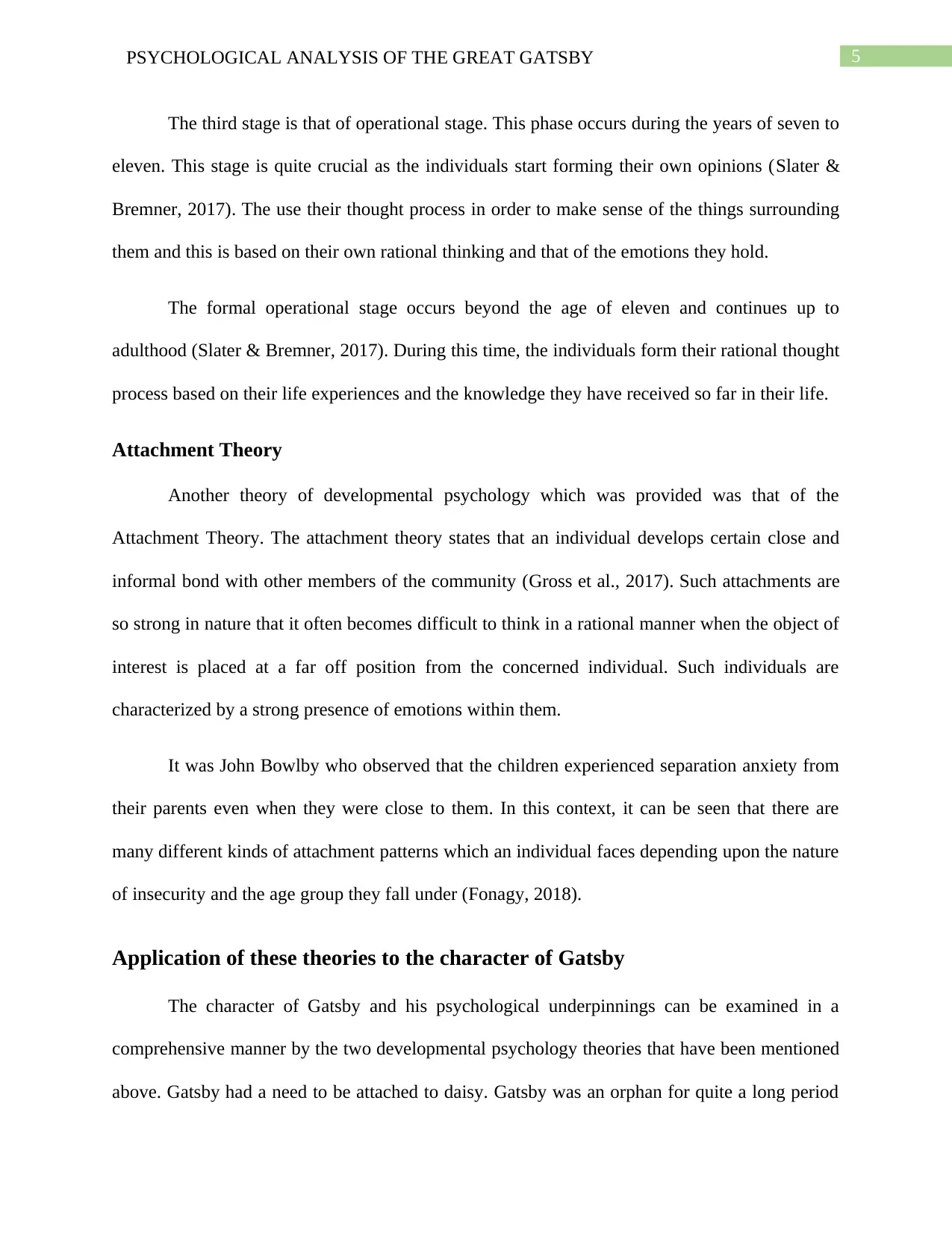
5PSYCHOLOGICAL ANALYSIS OF THE GREAT GATSBY
The third stage is that of operational stage. This phase occurs during the years of seven to
eleven. This stage is quite crucial as the individuals start forming their own opinions (Slater &
Bremner, 2017). The use their thought process in order to make sense of the things surrounding
them and this is based on their own rational thinking and that of the emotions they hold.
The formal operational stage occurs beyond the age of eleven and continues up to
adulthood (Slater & Bremner, 2017). During this time, the individuals form their rational thought
process based on their life experiences and the knowledge they have received so far in their life.
Attachment Theory
Another theory of developmental psychology which was provided was that of the
Attachment Theory. The attachment theory states that an individual develops certain close and
informal bond with other members of the community (Gross et al., 2017). Such attachments are
so strong in nature that it often becomes difficult to think in a rational manner when the object of
interest is placed at a far off position from the concerned individual. Such individuals are
characterized by a strong presence of emotions within them.
It was John Bowlby who observed that the children experienced separation anxiety from
their parents even when they were close to them. In this context, it can be seen that there are
many different kinds of attachment patterns which an individual faces depending upon the nature
of insecurity and the age group they fall under (Fonagy, 2018).
Application of these theories to the character of Gatsby
The character of Gatsby and his psychological underpinnings can be examined in a
comprehensive manner by the two developmental psychology theories that have been mentioned
above. Gatsby had a need to be attached to daisy. Gatsby was an orphan for quite a long period
The third stage is that of operational stage. This phase occurs during the years of seven to
eleven. This stage is quite crucial as the individuals start forming their own opinions (Slater &
Bremner, 2017). The use their thought process in order to make sense of the things surrounding
them and this is based on their own rational thinking and that of the emotions they hold.
The formal operational stage occurs beyond the age of eleven and continues up to
adulthood (Slater & Bremner, 2017). During this time, the individuals form their rational thought
process based on their life experiences and the knowledge they have received so far in their life.
Attachment Theory
Another theory of developmental psychology which was provided was that of the
Attachment Theory. The attachment theory states that an individual develops certain close and
informal bond with other members of the community (Gross et al., 2017). Such attachments are
so strong in nature that it often becomes difficult to think in a rational manner when the object of
interest is placed at a far off position from the concerned individual. Such individuals are
characterized by a strong presence of emotions within them.
It was John Bowlby who observed that the children experienced separation anxiety from
their parents even when they were close to them. In this context, it can be seen that there are
many different kinds of attachment patterns which an individual faces depending upon the nature
of insecurity and the age group they fall under (Fonagy, 2018).
Application of these theories to the character of Gatsby
The character of Gatsby and his psychological underpinnings can be examined in a
comprehensive manner by the two developmental psychology theories that have been mentioned
above. Gatsby had a need to be attached to daisy. Gatsby was an orphan for quite a long period
⊘ This is a preview!⊘
Do you want full access?
Subscribe today to unlock all pages.

Trusted by 1+ million students worldwide
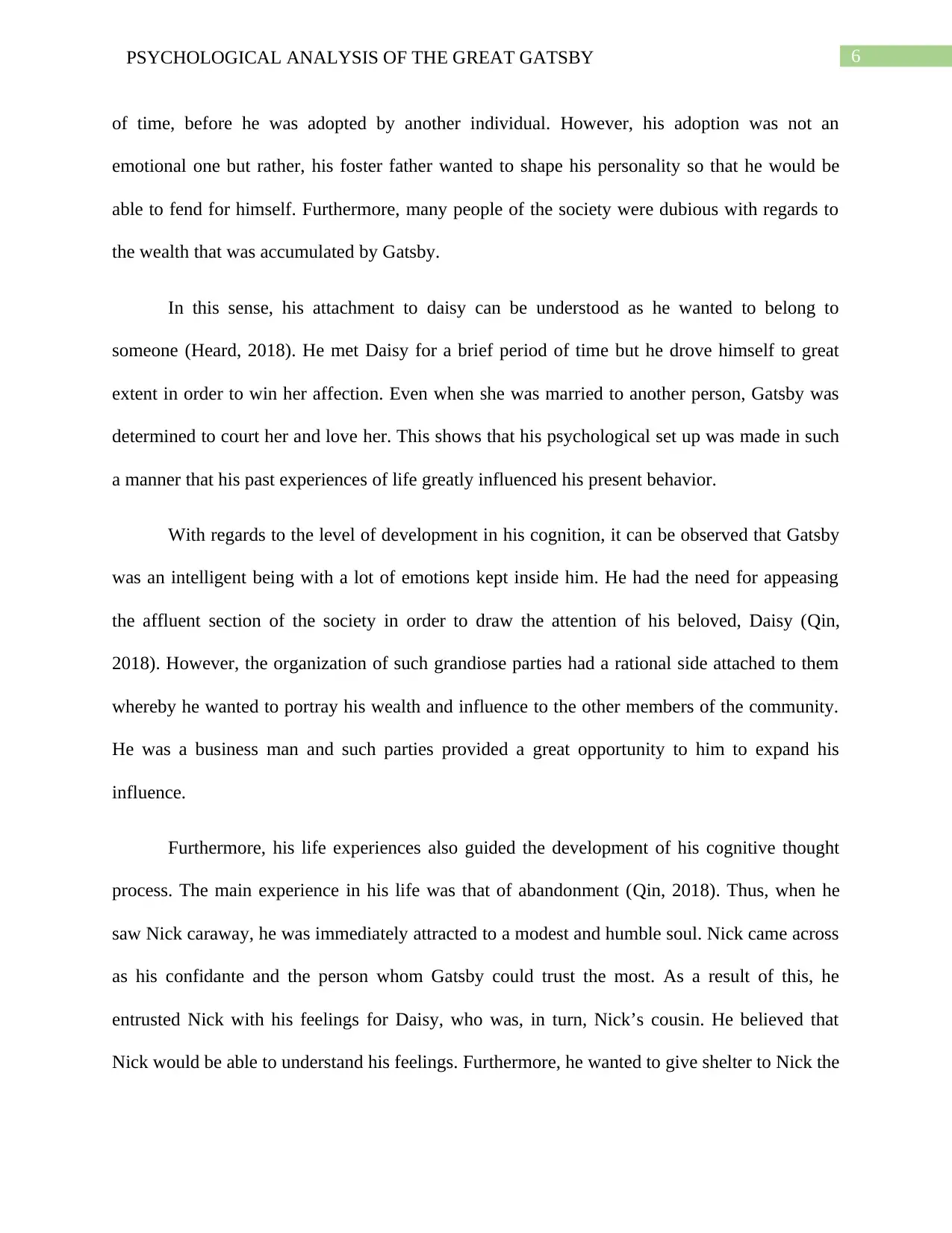
6PSYCHOLOGICAL ANALYSIS OF THE GREAT GATSBY
of time, before he was adopted by another individual. However, his adoption was not an
emotional one but rather, his foster father wanted to shape his personality so that he would be
able to fend for himself. Furthermore, many people of the society were dubious with regards to
the wealth that was accumulated by Gatsby.
In this sense, his attachment to daisy can be understood as he wanted to belong to
someone (Heard, 2018). He met Daisy for a brief period of time but he drove himself to great
extent in order to win her affection. Even when she was married to another person, Gatsby was
determined to court her and love her. This shows that his psychological set up was made in such
a manner that his past experiences of life greatly influenced his present behavior.
With regards to the level of development in his cognition, it can be observed that Gatsby
was an intelligent being with a lot of emotions kept inside him. He had the need for appeasing
the affluent section of the society in order to draw the attention of his beloved, Daisy (Qin,
2018). However, the organization of such grandiose parties had a rational side attached to them
whereby he wanted to portray his wealth and influence to the other members of the community.
He was a business man and such parties provided a great opportunity to him to expand his
influence.
Furthermore, his life experiences also guided the development of his cognitive thought
process. The main experience in his life was that of abandonment (Qin, 2018). Thus, when he
saw Nick caraway, he was immediately attracted to a modest and humble soul. Nick came across
as his confidante and the person whom Gatsby could trust the most. As a result of this, he
entrusted Nick with his feelings for Daisy, who was, in turn, Nick’s cousin. He believed that
Nick would be able to understand his feelings. Furthermore, he wanted to give shelter to Nick the
of time, before he was adopted by another individual. However, his adoption was not an
emotional one but rather, his foster father wanted to shape his personality so that he would be
able to fend for himself. Furthermore, many people of the society were dubious with regards to
the wealth that was accumulated by Gatsby.
In this sense, his attachment to daisy can be understood as he wanted to belong to
someone (Heard, 2018). He met Daisy for a brief period of time but he drove himself to great
extent in order to win her affection. Even when she was married to another person, Gatsby was
determined to court her and love her. This shows that his psychological set up was made in such
a manner that his past experiences of life greatly influenced his present behavior.
With regards to the level of development in his cognition, it can be observed that Gatsby
was an intelligent being with a lot of emotions kept inside him. He had the need for appeasing
the affluent section of the society in order to draw the attention of his beloved, Daisy (Qin,
2018). However, the organization of such grandiose parties had a rational side attached to them
whereby he wanted to portray his wealth and influence to the other members of the community.
He was a business man and such parties provided a great opportunity to him to expand his
influence.
Furthermore, his life experiences also guided the development of his cognitive thought
process. The main experience in his life was that of abandonment (Qin, 2018). Thus, when he
saw Nick caraway, he was immediately attracted to a modest and humble soul. Nick came across
as his confidante and the person whom Gatsby could trust the most. As a result of this, he
entrusted Nick with his feelings for Daisy, who was, in turn, Nick’s cousin. He believed that
Nick would be able to understand his feelings. Furthermore, he wanted to give shelter to Nick the
Paraphrase This Document
Need a fresh take? Get an instant paraphrase of this document with our AI Paraphraser
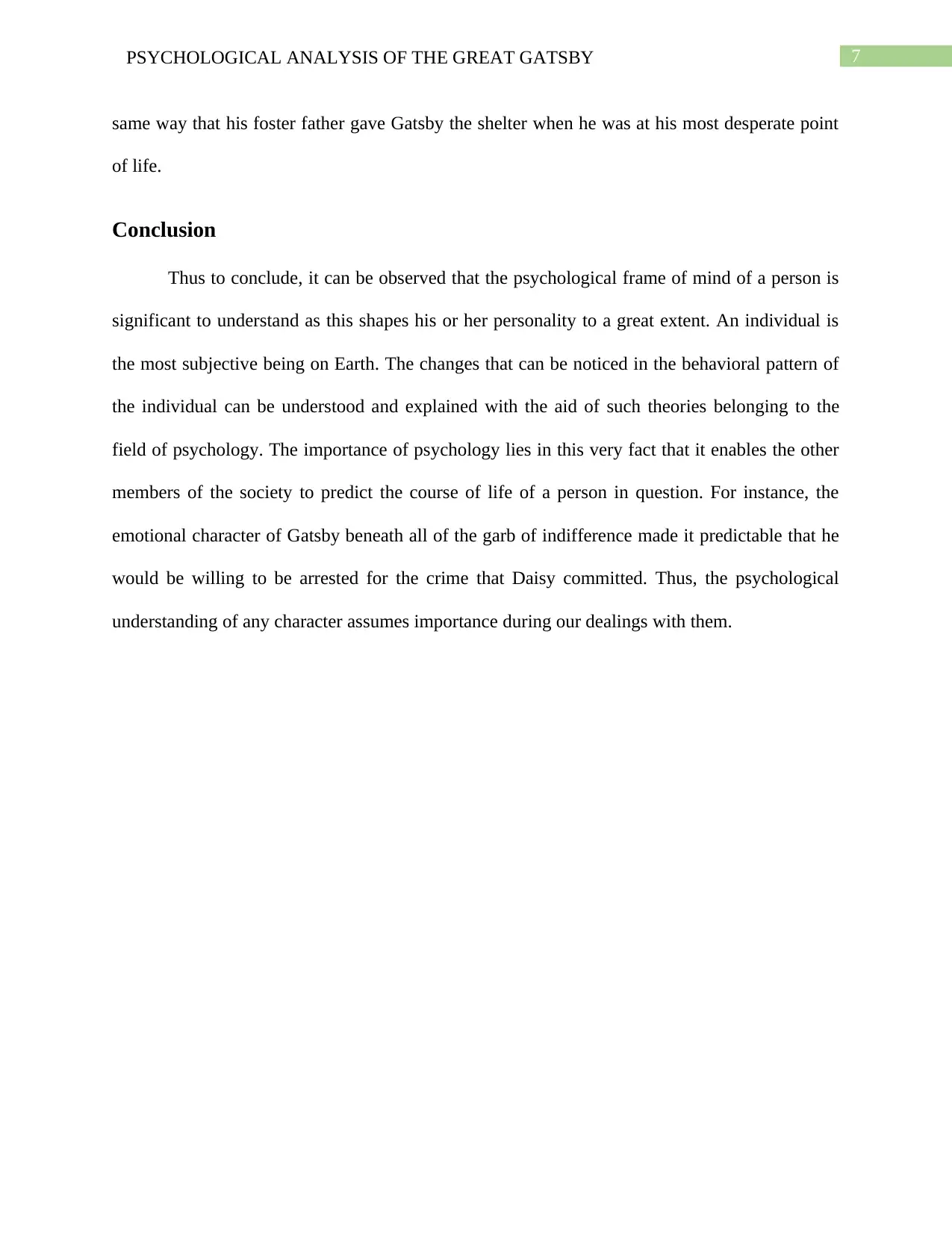
7PSYCHOLOGICAL ANALYSIS OF THE GREAT GATSBY
same way that his foster father gave Gatsby the shelter when he was at his most desperate point
of life.
Conclusion
Thus to conclude, it can be observed that the psychological frame of mind of a person is
significant to understand as this shapes his or her personality to a great extent. An individual is
the most subjective being on Earth. The changes that can be noticed in the behavioral pattern of
the individual can be understood and explained with the aid of such theories belonging to the
field of psychology. The importance of psychology lies in this very fact that it enables the other
members of the society to predict the course of life of a person in question. For instance, the
emotional character of Gatsby beneath all of the garb of indifference made it predictable that he
would be willing to be arrested for the crime that Daisy committed. Thus, the psychological
understanding of any character assumes importance during our dealings with them.
same way that his foster father gave Gatsby the shelter when he was at his most desperate point
of life.
Conclusion
Thus to conclude, it can be observed that the psychological frame of mind of a person is
significant to understand as this shapes his or her personality to a great extent. An individual is
the most subjective being on Earth. The changes that can be noticed in the behavioral pattern of
the individual can be understood and explained with the aid of such theories belonging to the
field of psychology. The importance of psychology lies in this very fact that it enables the other
members of the society to predict the course of life of a person in question. For instance, the
emotional character of Gatsby beneath all of the garb of indifference made it predictable that he
would be willing to be arrested for the crime that Daisy committed. Thus, the psychological
understanding of any character assumes importance during our dealings with them.
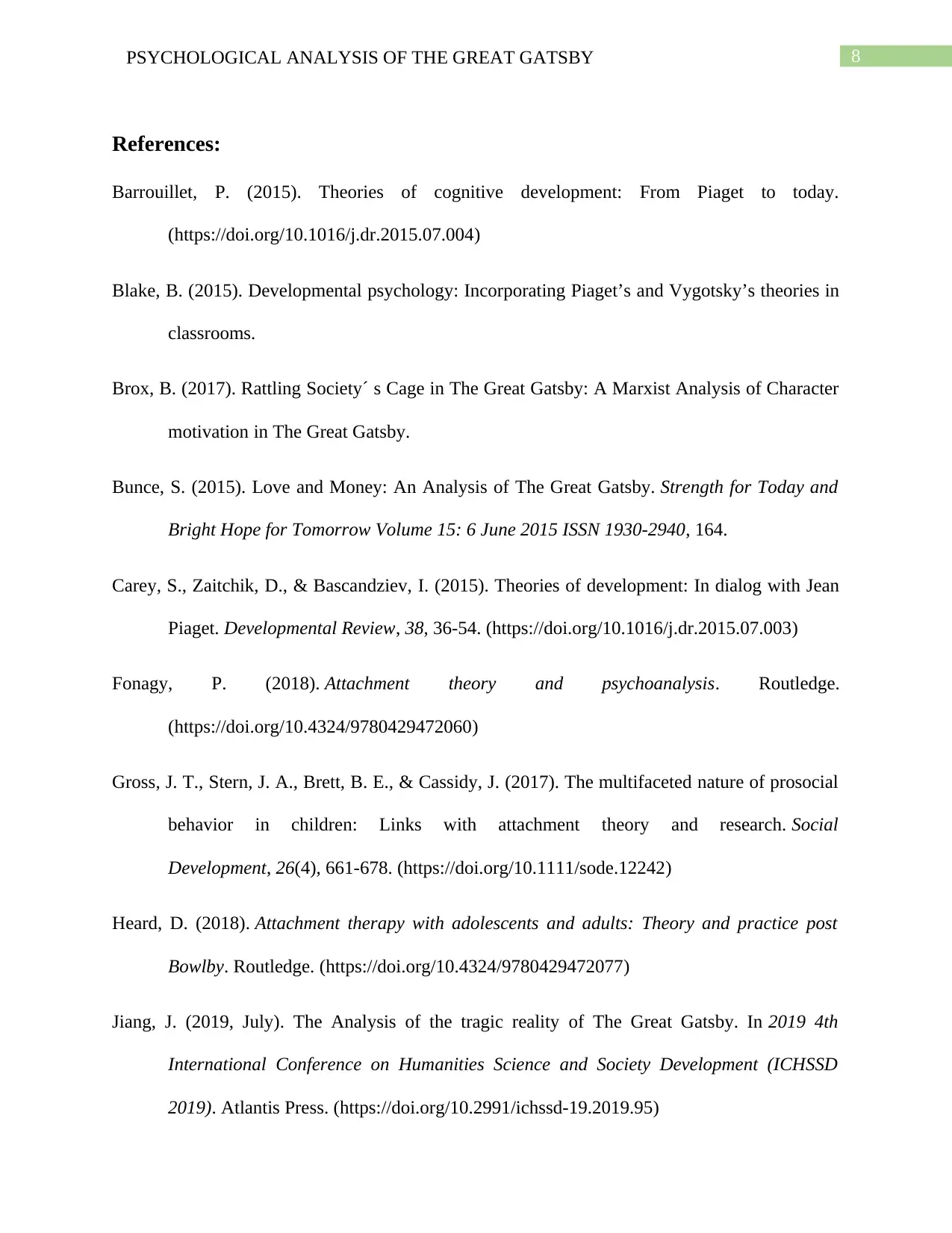
8PSYCHOLOGICAL ANALYSIS OF THE GREAT GATSBY
References:
Barrouillet, P. (2015). Theories of cognitive development: From Piaget to today.
(https://doi.org/10.1016/j.dr.2015.07.004)
Blake, B. (2015). Developmental psychology: Incorporating Piaget’s and Vygotsky’s theories in
classrooms.
Brox, B. (2017). Rattling Society´ s Cage in The Great Gatsby: A Marxist Analysis of Character
motivation in The Great Gatsby.
Bunce, S. (2015). Love and Money: An Analysis of The Great Gatsby. Strength for Today and
Bright Hope for Tomorrow Volume 15: 6 June 2015 ISSN 1930-2940, 164.
Carey, S., Zaitchik, D., & Bascandziev, I. (2015). Theories of development: In dialog with Jean
Piaget. Developmental Review, 38, 36-54. (https://doi.org/10.1016/j.dr.2015.07.003)
Fonagy, P. (2018). Attachment theory and psychoanalysis. Routledge.
(https://doi.org/10.4324/9780429472060)
Gross, J. T., Stern, J. A., Brett, B. E., & Cassidy, J. (2017). The multifaceted nature of prosocial
behavior in children: Links with attachment theory and research. Social
Development, 26(4), 661-678. (https://doi.org/10.1111/sode.12242)
Heard, D. (2018). Attachment therapy with adolescents and adults: Theory and practice post
Bowlby. Routledge. (https://doi.org/10.4324/9780429472077)
Jiang, J. (2019, July). The Analysis of the tragic reality of The Great Gatsby. In 2019 4th
International Conference on Humanities Science and Society Development (ICHSSD
2019). Atlantis Press. (https://doi.org/10.2991/ichssd-19.2019.95)
References:
Barrouillet, P. (2015). Theories of cognitive development: From Piaget to today.
(https://doi.org/10.1016/j.dr.2015.07.004)
Blake, B. (2015). Developmental psychology: Incorporating Piaget’s and Vygotsky’s theories in
classrooms.
Brox, B. (2017). Rattling Society´ s Cage in The Great Gatsby: A Marxist Analysis of Character
motivation in The Great Gatsby.
Bunce, S. (2015). Love and Money: An Analysis of The Great Gatsby. Strength for Today and
Bright Hope for Tomorrow Volume 15: 6 June 2015 ISSN 1930-2940, 164.
Carey, S., Zaitchik, D., & Bascandziev, I. (2015). Theories of development: In dialog with Jean
Piaget. Developmental Review, 38, 36-54. (https://doi.org/10.1016/j.dr.2015.07.003)
Fonagy, P. (2018). Attachment theory and psychoanalysis. Routledge.
(https://doi.org/10.4324/9780429472060)
Gross, J. T., Stern, J. A., Brett, B. E., & Cassidy, J. (2017). The multifaceted nature of prosocial
behavior in children: Links with attachment theory and research. Social
Development, 26(4), 661-678. (https://doi.org/10.1111/sode.12242)
Heard, D. (2018). Attachment therapy with adolescents and adults: Theory and practice post
Bowlby. Routledge. (https://doi.org/10.4324/9780429472077)
Jiang, J. (2019, July). The Analysis of the tragic reality of The Great Gatsby. In 2019 4th
International Conference on Humanities Science and Society Development (ICHSSD
2019). Atlantis Press. (https://doi.org/10.2991/ichssd-19.2019.95)
⊘ This is a preview!⊘
Do you want full access?
Subscribe today to unlock all pages.

Trusted by 1+ million students worldwide
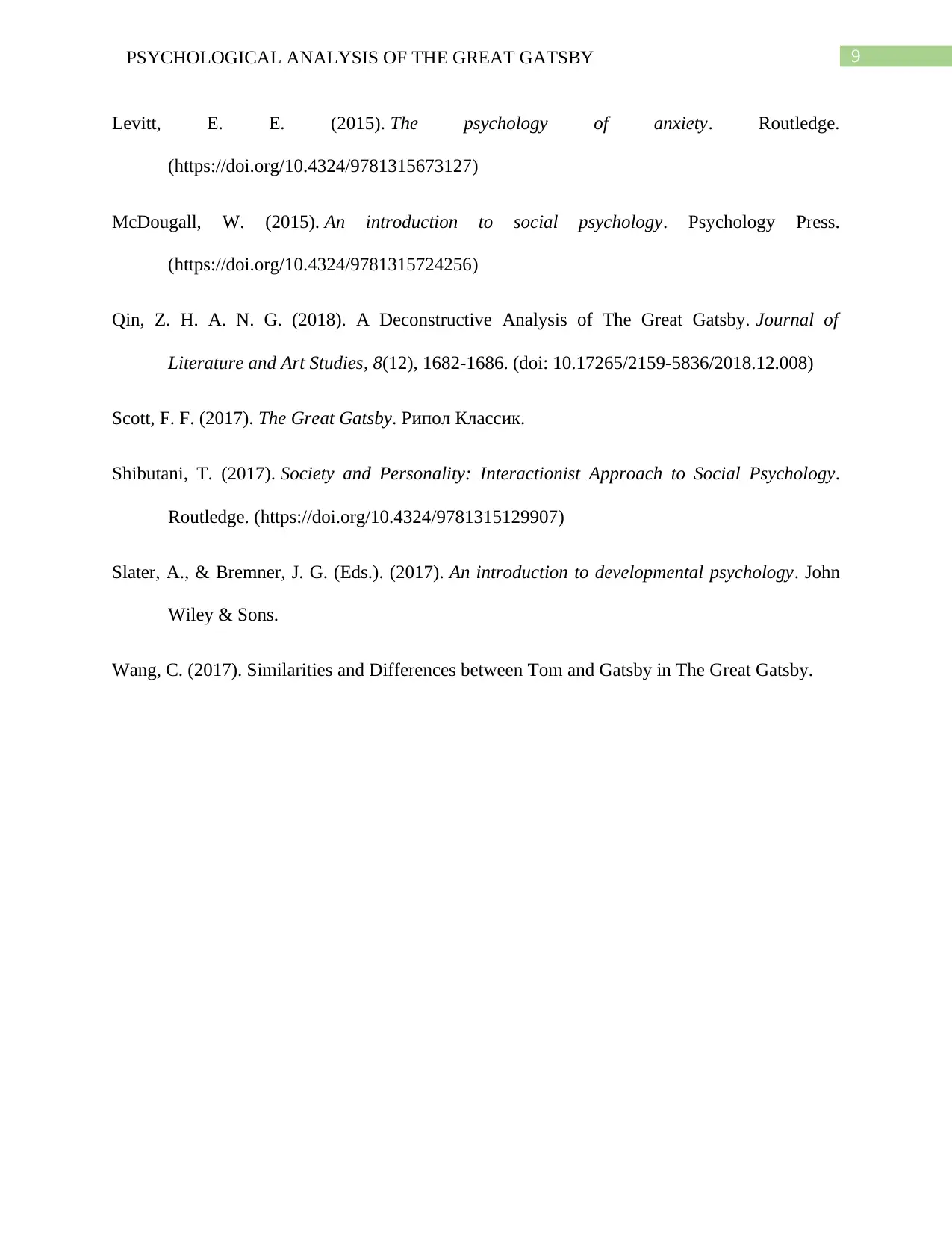
9PSYCHOLOGICAL ANALYSIS OF THE GREAT GATSBY
Levitt, E. E. (2015). The psychology of anxiety. Routledge.
(https://doi.org/10.4324/9781315673127)
McDougall, W. (2015). An introduction to social psychology. Psychology Press.
(https://doi.org/10.4324/9781315724256)
Qin, Z. H. A. N. G. (2018). A Deconstructive Analysis of The Great Gatsby. Journal of
Literature and Art Studies, 8(12), 1682-1686. (doi: 10.17265/2159-5836/2018.12.008)
Scott, F. F. (2017). The Great Gatsby. Рипол Классик.
Shibutani, T. (2017). Society and Personality: Interactionist Approach to Social Psychology.
Routledge. (https://doi.org/10.4324/9781315129907)
Slater, A., & Bremner, J. G. (Eds.). (2017). An introduction to developmental psychology. John
Wiley & Sons.
Wang, C. (2017). Similarities and Differences between Tom and Gatsby in The Great Gatsby.
Levitt, E. E. (2015). The psychology of anxiety. Routledge.
(https://doi.org/10.4324/9781315673127)
McDougall, W. (2015). An introduction to social psychology. Psychology Press.
(https://doi.org/10.4324/9781315724256)
Qin, Z. H. A. N. G. (2018). A Deconstructive Analysis of The Great Gatsby. Journal of
Literature and Art Studies, 8(12), 1682-1686. (doi: 10.17265/2159-5836/2018.12.008)
Scott, F. F. (2017). The Great Gatsby. Рипол Классик.
Shibutani, T. (2017). Society and Personality: Interactionist Approach to Social Psychology.
Routledge. (https://doi.org/10.4324/9781315129907)
Slater, A., & Bremner, J. G. (Eds.). (2017). An introduction to developmental psychology. John
Wiley & Sons.
Wang, C. (2017). Similarities and Differences between Tom and Gatsby in The Great Gatsby.
1 out of 10
Related Documents
Your All-in-One AI-Powered Toolkit for Academic Success.
+13062052269
info@desklib.com
Available 24*7 on WhatsApp / Email
![[object Object]](/_next/static/media/star-bottom.7253800d.svg)
Unlock your academic potential
Copyright © 2020–2025 A2Z Services. All Rights Reserved. Developed and managed by ZUCOL.





